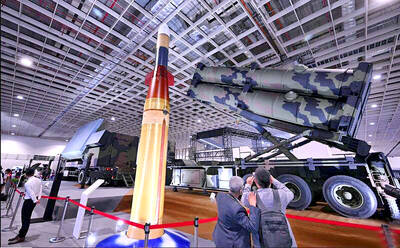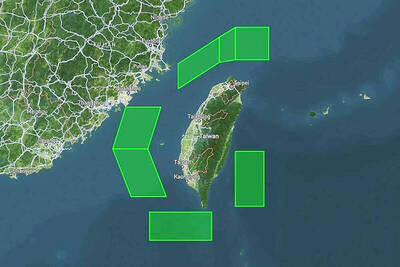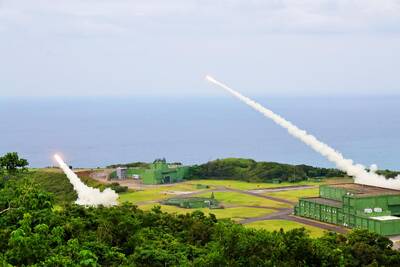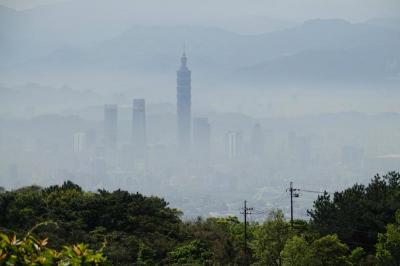National Tsing Hua University professor of materials science Yeh Jien-wei (葉均蔚), who pioneered research into high-entropy alloys, was given special coverage in the academic journal Nature for his contribution creating the next generation of alloys.
Yeh came up with the idea of high-entropy alloys in 1995, while he was driving through the Hsinchu countryside, and the idea has evolved into a fast-moving field that attracts increasingly more scientists and funding on a global scale, Yeh told a news conference held by the Ministry of Science and Technology last week.
Unlike traditional alloys, which are made by mixing a primary metal with a small amount of other elements, high-entropy alloys consist of four, five or more elements mixed together in roughly equal ratios, he said.
Pure metals have a regular atomic structure with identical layers stacked upon each other and those layers slip past each other easily, whereas mixing a metal with another element with a different atomic size can stop slipping and create a harder alloy, he said.
However, it was believed that if too much of the alloying metal was added, a regular atomic structure might be formed when atoms of the alloying and primary metals arrange themselves in a regular pattern, thereby producing a weak and brittle compound, Yeh said.
“I came up with the idea of mixing similar quantities of four or five elements, which increases the number of ways for different atoms to alternate with each other, thereby creating a disorder, or ‘high entropy,’ that would prevent the formation of a regular atomic structure,” he added.
High-entropy alloys can be lighter and stronger than conventional alloys, while being much more resistant to corrosion, radiation or severe wear, he said.
In 2004, a team led by Yeah created the first high-entropy alloy by mixing five to 10 elements to produce alloys that were considerably harder than stainless steel, and the field of high-entropy alloys began to evolve rapidly after that.
There are more than 300 research facilities around the world that are developing high-entropy alloys, and more than 1,000 academic essays have been published on the subject.
“Alloys with remarkable properties have been created over the past 10 years. An alloy used to make jet engines can resist temperatures up to 1,150oC and improve engine performance by 4 percent. Scientists have also developed alloys that can resist radiation to be used in nuclear power plants, as well as alloys with superconductivity. Maybe we can create a UFO-like spacecraft some day,” he said.
Yeh is dubbed the “father of high-entropy alloys” and the Nature story, which was published last month, details how he revolutionized the field of materials science.

Taiwan is to commence mass production of the Tien Kung (天弓, “Sky Bow”) III, IV and V missiles by the second quarter of this year if the legislature approves the government’s NT$1.25 trillion (US$39.78 billion) special defense budget, an official said yesterday. Commenting on condition of anonymity, a defense official with knowledge of the matter said that the advanced systems are expected to provide crucial capabilities against ballistic and cruise missiles for the proposed “T-Dome,” an advanced, multi-layered air defense network. The Tien Kung III is an air defense missile with a maximum interception altitude of 35km. The Tien Kung IV and V

The disruption of 941 flights in and out of Taiwan due to China’s large-scale military exercises was no accident, but rather the result of a “quasi-blockade” used to simulate creating the air and sea routes needed for an amphibious landing, a military expert said. The disruptions occurred on Tuesday and lasted about 10 hours as China conducted live-fire drills in the Taiwan Strait. The Civil Aviation Administration (CAA) said the exercises affected 857 international flights and 84 domestic flights, affecting more than 100,000 travelers. Su Tzu-yun (蘇紫雲), a research fellow at the government-sponsored Institute for National Defense and Security Research, said the air

Taiwan lacks effective and cost-efficient armaments to intercept rockets, making the planned “T-Dome” interception system necessary, two experts said on Tuesday. The concerns were raised after China’s military fired two waves of rockets during live-fire drills around Taiwan on Tuesday, part of two-day exercises code-named “Justice Mission 2025.” The first wave involved 17 rockets launched at 9am from Pingtan in China’s Fujian Province, according to Lieutenant General Hsieh Jih-sheng (謝日升) of the Office of the Deputy Chief of the General Staff for Intelligence at the Ministry of National Defense. Those rockets landed 70 nautical miles (129.6km) northeast of Keelung without flying over Taiwan,

A strong continental cold air mass is to bring pollutants to Taiwan from tomorrow, the Ministry of Environment said today, as it issued an “orange” air quality alert for most of the country. All of Taiwan except for Hualien and Taitung counties is to be under an “orange” air quality alert tomorrow, indicating air quality that is unhealthy for sensitive groups. In China, areas from Shandong to Shanghai have been enveloped in haze since Saturday, the ministry said in a news release. Yesterday, hourly concentrations of PM2.5 in these areas ranged from 65 to 160 micrograms per cubic meter (mg/m³), and pollutants were